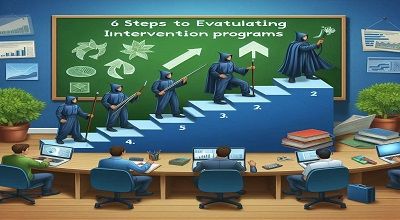Steps to Evaluating Intervention Programs
Evaluating intervention programs is essential to determine their effectiveness and make informed decisions about resource allocation and program improvement. Here are six steps to help you evaluate intervention programs:
Define Clear Objectives and Goals:
- Start by defining the specific objectives and goals of the intervention program. What do you aim to achieve? These objectives should be specific, measurable, achievable, relevant, and time-bound (SMART). Ensure that the objectives align with the program’s mission and the needs of the target population.
Select Appropriate Evaluation Methods:
- Choose the evaluation methods that are best suited to assess the program’s impact and effectiveness. Common evaluation methods include quantitative surveys, qualitative interviews, focus groups, case studies, and pre-post comparisons. Select the methods that align with your program’s objectives and resources.
Develop Evaluation Metrics and Indicators:
- Identify key performance metrics and indicators that can help you measure the program’s success. These may include changes in knowledge, behavior, or outcomes. Be sure to establish baseline data to compare against during and after the intervention. Collect data consistently throughout the program’s implementation.
Collect and Analyze Data:
- Gather data through the chosen evaluation methods. Ensure that data collection is systematic and unbiased. Analyze the collected data to assess the program’s impact. Use statistical analysis and data visualization techniques to interpret the results and identify trends or patterns.
Assess Program Implementation:
- Evaluate not only the outcomes but also the implementation of the program. Examine whether the program was delivered as intended, adhered to best practices, and met its objectives. This process may involve assessing fidelity to the intervention model and identifying any barriers or challenges in implementation.
Report Findings and Make Recommendations:
- Prepare a comprehensive evaluation report that includes the findings, conclusions, and recommendations. Share the results with stakeholders, including program funders, staff, and participants. Use the findings to make informed decisions about program continuation, expansion, modification, or discontinuation.
Summary
Additionally, consider involving a diverse group of stakeholders in the evaluation process to gain multiple perspectives and ensure a well-rounded assessment of the program’s impact. Regularly review and update your evaluation plan to adapt to changing circumstances and improve the program’s effectiveness. Evaluation is an ongoing process that can lead to continuous program improvement and better outcomes for the target population.
